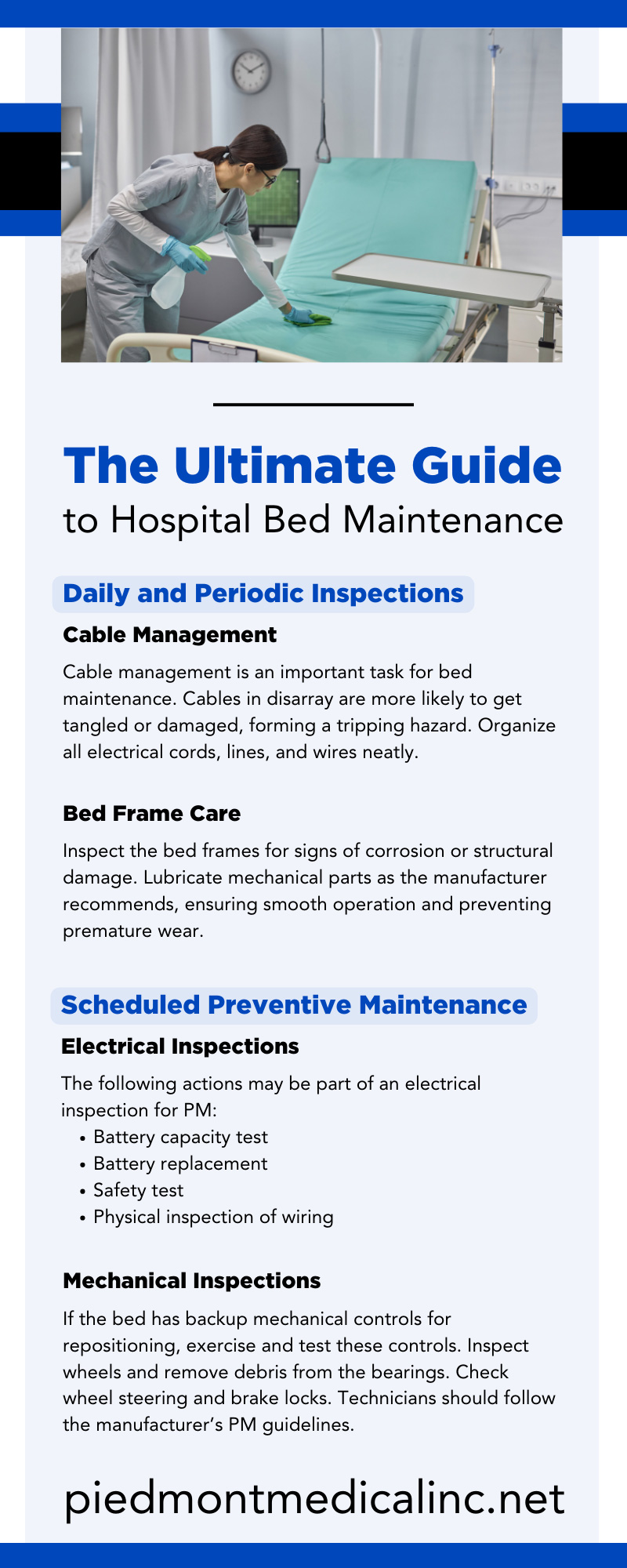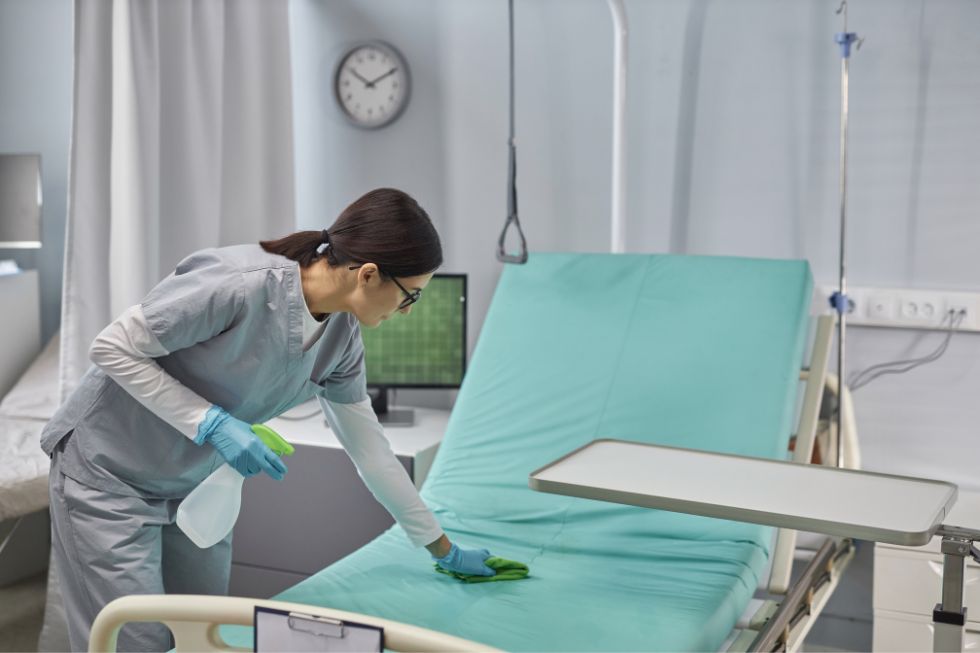Hospital beds are invaluable support tools for patient care. Precise controls and smooth adjustments facilitate independent mobility or help caregivers reposition patients more easily.
Basic maintenance helps ensure the proper performance of your medical equipment. Use this ultimate guide to hospital bed maintenance to retain functionality that improves each patient’s comfort and safety.
Daily and Periodic Inspections
Healthcare staff should visually inspect the hospital beds at the start of every shift. They should check for visible damage, loose bolts, and worn-out components.
A third-party company or your facility’s preventive maintenance department should perform a more in-depth annual inspection of all beds. Preventative maintenance is detailed later in this article, but the following aspects should be checked by staff daily.
Cable Management
Cable management is an important task for bed maintenance. Cables in disarray are more likely to get tangled or damaged, forming a tripping hazard. Organize all electrical cords, lines, and wires neatly.
Bed Frame Care
Inspect the bed frames for signs of corrosion or structural damage. Lubricate mechanical parts as the manufacturer recommends, ensuring smooth operation and preventing premature wear.
Tip: Make Prompt Repairs
If you notice issues or malfunctions with a bed, have an authorized technician inspect the bed and perform prompt repairs. Do not wait for damage to become more complex.
Bed Frame Cleaning
Patients come into contact with hospital beds more frequently than they do with any other medical equipment. Therefore, cleaning the frames and mattresses is crucial for preventing nosocomial infections.
Hand-wash each bed surface with a soft, moistened cloth. Use warm water and mild detergent rather than harsh cleaners.
Wipe the beds with a dry cloth to remove extra cleaning products, and let them completely air-dry.
Mattress Care
One of the ultimate tips for hospital bed maintenance is to take care of the mattresses. Damaged mattresses can harbor dangerous pathogens such as MRSA, which causes staph infections that are difficult to treat, and C difficile, which causes diarrhea and colitis.
Proper cleaning and repairing the damaged mattress to an intact state will stop mattress-associated infections. Remember that hospital mattresses are most effective for five to six years; after that time, it may be prudent to replace the mattresses.
Bedside Mattress Inspections
Perform a bedside mattress inspection every time a patient is discharged or transferred from a patient’s room. Check every mattress for these visible signs of damage:
- Cuts
- Pinhole punctures
- Tears
- Snags
- Stains—these indicate fluid ingress
Scraping a mattress against a wall or door can cause abrasions. Patient transfer devices like sliding boards can also break the surface of a mattress.
Use an FDA-registered medical surface repair product to return the affected mattress to an intact state. Otherwise, replace the mattress promptly.
Tip: Clean the Mattress Carefully
Cleaning and disinfecting products can harm and loosen a mattress’s fabric, creating weak spots and holes. Follow your mattress manufacturer’s cleaning instructions for best results.
Avoid abrasive cleaners and high-concentration disinfectants. And always allow the mattress surface to dry before handling.
Secondary Mattress Inspections
Every 6 to 12 months, perform a secondary mattress inspection outside patient areas. Ensure the mattresses can provide adequate support to the patients.
Inspect the mattress covers for tears, cracks, warping, and stains. Ensure zippers are functional.
Remove the mattress covers to inspect the inner cores. Replace a mattress if the core has stains or an odor.
Tip: Always Use Barrier Protectors
Barrier protection, such as mattress covers and bed pads, prevent body fluids and other liquids from reaching the mattress surfaces. Mattress toppers reduce the need for mattress repair and are easy to replace.
Scheduled Preventive Maintenance
Your facility’s biomedical engineering department may maintain and repair patient beds, or a third-party company may assume the responsibility. Preventive maintenance (PM) of hospital beds prevents mechanical failure, inaccurate readings, and overheating.
Maintain detailed records of maintenance and inspections performed on each bed. Documentation will keep track of every bed’s history, including repairs and patterns of wear and tear.
PM technicians follow their particular facility’s protocols. Broadly speaking, the PM team will assess each bed’s electrical and mechanical components and perform sanitary inspections.
Electrical Inspections
Intricate electrical components control height adjustment, backrest tilt, and other patient positioning functions. Electrical maintenance ensures the reliability of these features and minimizes malfunction risk.
The following actions may be part of an electrical inspection for PM:
- Battery capacity test
- Battery replacement
- Safety test
- Physical inspection of wiring
During the safety test, tilt the bed fully to ensure controls function as intended. Also, inspect protective coatings on wires to ensure internal components have not worn through. Flex wires on remote hand controls to test strain.
Mechanical Inspections
Verify that all bolts and screws are tightened. Check that the footboard and the headboard are secure.
If the bed has backup mechanical controls for repositioning, exercise and test these controls. Inspect wheels and remove debris from the bearings. Check wheel steering and brake locks.
Technicians should follow the manufacturer’s PM guidelines. The annual checklist includes detailed instructions, such as inspecting oil-impregnated bronze shoulder spacers in the linkage of the mattress support sections and the Hi-Lo lever mechanism.
Inspect and tighten bolts and screws. Check that the bed rails move and latch properly.
Apply Grease Where Recommended
Follow your bed manufacturer’s inspection recommendations. Misapplying lubricants, such as lubricating shoulder spacers, can cause the bed to malfunction.
In general, you should check the following parts and apply lubricant as needed:
- Actuator screws: Multiple actuators power bed sections’ vertical and horizontal movements.
- Clevis pins: These U-shaped attachments hook actuator tubes.
Use the manufacturer’s recommended grease for lubrication. Lubricating the bed with other products can cause critical components to deteriorate, damaging the bed and putting patients at risk for injury.
Sanitary Inspections
Verify that the bed has no sharp protrusions or edges. File or sand down rough edges to ensure the bed doesn’t cut patients or staff.
Inspect the mattress for loose seams, cracks, and tears. If fluids can enter the mattress, the bed can become contaminated and increase the risk of healthcare-associated infections. Replace faulty mattresses immediately.
Mechanical, electrical, and sanitary inspections protect patients from physical and biological hazards. Technicians should conduct PM on every bed annually. Additionally, if a bed requires repair, the technician should perform PM to ensure proper performance.
Source Quality Hospital Beds
Quality hospital beds have greater functionality and more precise controls. Safe patient beds are important in every hospital unit, but even more so in high-acuity areas where the quality of care greatly impacts patient survival.
Equip your hospital with Hill-Rom ICU beds from Piedmont Medical. You’ll find reconditioned beds in like-new condition with responsive controls, such as emergency CPR release functions. Shop with us today for reliable and affordable hospital bed solutions.



I would like to request a quote for a Maintenance Agreement for 40 Centrella Beds in Albuquerque, NM at 5400 Gibson Blvd SE Box 13, Albuquerque, NM 87108